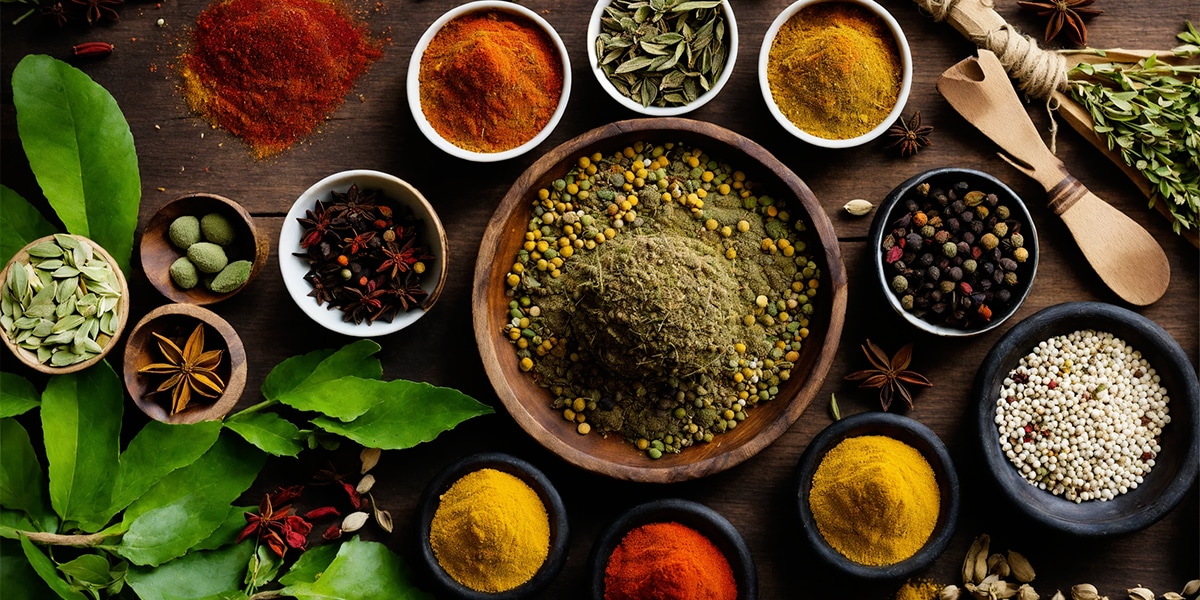In the intricate tapestry of wellness and health, diabetes stands out as a chronic condition that has been intricately woven into the lives of millions worldwide. This metabolic disorder, characterized by high blood sugar levels over a prolonged period, is not just a health issue but a lifestyle challenge that impacts daily living. The quest for sustainable and holistic management strategies brings us to the ancient wisdom of Ayurveda, a system of medicine with roots deep in the history of the Indian subcontinent.
Ayurveda, which translates to “science of life,” offers a treasure trove of herbal remedies aimed at not only controlling diabetes but also at enhancing overall well-being. This guide delves into the heart of nature’s pharmacy, unveiling Ayurvedic herbs that have been revered for centuries for their ability to regulate blood sugar levels and support metabolic health.
The Ayurvedic Approach to Diabetes Control
Ayurveda perceives diabetes as a disorder of the metabolism or “Agni,” reflecting an imbalance in the body’s energy elements. The management of diabetes in Ayurveda is not just about controlling sugar levels but also about restoring balance and harmony within the body. Among the myriad of natural remedies it proposes, certain herbs stand out for their efficacy and the depth of research backing their use.
Intriguingly, these herbs are not just random plants but are a part of an elaborate philosophy that views health as a balance between the body, mind, and environment. For instance, Gymnema Sylvestre, known as the “sugar destroyer,” has compounds that can reduce the ability to taste sweetness and thus reduce sugar cravings. Similarly, Fenugreek seeds are not only potent antidiabetics but also have fiber that aids in digestion and improves metabolic health.
Gymnema Sylvestre: The Sugar Destroyer
Gymnema Sylvestre stands as a testament to Ayurveda’s profound understanding of natural remedies. This herb has garnered attention for its remarkable ability to reduce sugar absorption in the intestine and stimulate insulin production, acting as a natural ally in the fight against diabetes.
- Research highlights its role in enhancing insulin function, suggesting that it can help manage type 1 and type 2 diabetes effectively.
- Gymnema Sylvestre’s active component, Gymnemic acid, is known to block the sugar receptors on your taste buds, decreasing sugar cravings significantly.
- Its potential in regenerating pancreas cells has opened new avenues in diabetes management, making it a subject of intense study.
- Incorporating Gymnema Sylvestre into your diet can be as simple as taking supplements or brewing tea from its leaves, offering a natural way to complement conventional diabetes treatments.
Fenugreek: More Than Just a Culinary Spice
Fenugreek seeds, a common ingredient in kitchens around the globe, are celebrated in Ayurvedic medicine for their antidiabetic properties. These tiny seeds are packed with soluble fiber, which can slow down the absorption of carbohydrates and sugars.
- Clinical studies have shown that Fenugreek improves blood sugar control and reduces insulin resistance in people with diabetes.
- Its high fiber content is beneficial for heart health, aiding in the reduction of cholesterol levels.
- Fenugreek seeds can be soaked overnight and consumed in the morning, or powdered and used as a spice, making it an easy addition to the diabetic diet.
- The herb’s versatility and accessibility make it a popular choice for those seeking natural ways to manage diabetes and enhance their diet.
Cinnamon: A Fragrant Solution to Blood Sugar Regulation
Cinnamon, beyond its use as a flavorful spice, has been found to possess properties that can help lower blood sugar levels and improve insulin sensitivity.
- Studies suggest that cinnamon can mimic insulin, a feature that can be particularly beneficial for people with insulin resistance.
- Its bioactive components, including cinnamaldehyde, have been linked to reduced fasting blood sugar levels and improvements in cholesterol profiles.
- Integrating cinnamon into your diet can be as simple as adding it to your morning coffee or oatmeal, offering a delightful and healthful twist to your meals.
Bitter Melon: Nature’s Insulin
Bitter Melon, with its distinct appearance and taste, is a powerful Ayurvedic remedy for diabetes. It contains three active substances with antidiabetic properties that mimic insulin, improve glucose uptake, and enhance glycogen synthesis in the liver.
- Clinical trials have shown that Bitter Melon can significantly reduce blood glucose levels in patients with type 2 diabetes.
- It can be consumed in various forms, such as fresh juice, smoothies, or even cooked dishes, providing flexibility in how it can be incorporated into a diabetes management plan.
- Its insulin-like effects offer a promising avenue for those exploring natural adjunct treatments for diabetes.
Embracing Ayurvedic Dietary Practices for Diabetes Control
The ancient wisdom of Ayurveda extends beyond just herbs; it encompasses a comprehensive dietary guideline that harmonizes the body, mind, and spirit. Ayurvedic dietary practices for diabetes focus on balancing the three doshas (Vata, Pitta, and Kapha) with mindful eating habits that promote metabolic health and well-being.
Ayurveda emphasizes the importance of consuming whole, unprocessed foods that are naturally rich in nutrients and fiber. Such a diet aids in stabilizing blood sugar levels and supports overall digestive health. Foods like whole grains, legumes, vegetables, and fruits are central to an Ayurvedic diet, providing essential vitamins, minerals, and antioxidants that combat oxidative stress associated with diabetes.
Incorporating bitter and astringent tastes in meals is particularly beneficial for diabetes management. These tastes are known to help in reducing blood sugar levels and enhancing insulin sensitivity. Foods such as bitter gourd, amla (Indian gooseberry), and turmeric not only imbue dishes with flavor but also offer medicinal properties that align with diabetes care.
Ayurvedic principles also advise mindful eating practices, such as eating at regular intervals, consuming meals in a calm and relaxed environment, and listening to the body’s hunger and fullness cues. These practices encourage a balanced approach to food intake, preventing overeating and supporting healthy digestion and assimilation of nutrients.
| Herb | Main Benefits | Usage |
|---|---|---|
| Gymnema Sylvestre | Reduces sugar absorption, stimulates insulin production | Supplements, tea |
| Fenugreek | Improves blood sugar control, reduces insulin resistance | Soaked seeds, powdered spice |
| Cinnamon | Lowers blood sugar levels, improves insulin sensitivity | Added to food or drinks |
| Bitter Melon | Mimics insulin, improves glucose uptake | Juice, smoothies, cooked |
Integrating Lifestyle Changes with Ayurvedic Remedies
While Ayurvedic herbs provide a natural means to manage diabetes, integrating lifestyle changes enhances their efficacy, offering a synergistic approach to holistic health. Ayurveda advocates for a lifestyle that promotes balance, vitality, and harmony, emphasizing the significance of regular physical activity, adequate sleep, and stress management.
Physical activity is a cornerstone of diabetes management, improving insulin sensitivity and aiding in blood sugar control. Ayurveda recommends gentle, consistent forms of exercise that balance the doshas, such as yoga, walking, and swimming. These activities not only support physical health but also promote mental well-being.
Adequate rest and sleep are equally important in Ayurvedic practice. They rejuvenate the body and mind, regulate hormonal balance, and support the body’s natural healing processes. Ayurveda suggests establishing a regular sleep routine, going to bed and waking up at the same times each day to align with the natural circadian rhythm.
Stress management is crucial in controlling diabetes, as stress can significantly impact blood sugar levels. Ayurvedic practices such as meditation, pranayama (breath control exercises), and mindfulness can be powerful tools in reducing stress and enhancing emotional and psychological well-being.
By embracing these lifestyle changes alongside Ayurvedic herbal remedies, individuals can achieve a more comprehensive and effective management of diabetes. This holistic approach not only addresses the physical aspects of the disease but also nurtures the mental and emotional dimensions, leading to improved health outcomes and quality of life.
Ayurvedic Herbs for Diabetes Control: Your FAQs Answered
Can Ayurvedic herbs cure diabetes?
Ayurvedic herbs are not a cure for diabetes but can significantly aid in managing the condition. They should be used in conjunction with a healthy diet and regular exercise.
How long does it take for these herbs to show effects?
The effects vary depending on the individual’s health, lifestyle, and consistency of use. Generally, improvements can be seen within a few weeks to months of regular use.
Are there any side effects of using Ayurvedic herbs for diabetes?
While Ayurvedic herbs are generally safe, they can interact with medications and may not be suitable for everyone. It’s crucial to consult a healthcare provider before starting any new supplement.
Can these herbs be used alongside conventional diabetes medications?
Yes, many of these herbs can be used in conjunction with conventional medications but always under the guidance of a healthcare professional to avoid potential interactions.
Where can I find these Ayurvedic herbs?
Most herbs are available in health food stores, online, or at stores specializing in Indian groceries. Look for reputable brands to ensure quality and purity.
How should these herbs be stored?
Most dried herbs should be stored in a cool, dry place away from direct sunlight. Fresh Bitter Melon should be kept in the refrigerator and used within a few days.
Is there a specific diet that should be followed while using these herbs?
A balanced diet that is low in simple sugars and high in fiber, alongside regular physical activity, enhances the effectiveness of these herbs.
Can children with diabetes use these herbs?
While some herbs may be safe for children, it is essential to consult a pediatric healthcare provider before introducing any new supplements.
Do these herbs interact with other herbal supplements?
Yes, herbal supplements can interact with each other. It’s important to discuss all supplements with a healthcare provider.
Can lifestyle changes enhance the effectiveness of these herbs?
Absolutely. A holistic approach, including stress management, regular exercise, and a balanced diet, significantly enhances the benefits of Ayurvedic herbs for diabetes control.
Citations
- Gymnema Sylvestre and Diabetes: Tiwari, P., Mishra, B. N., & Sangwan, N. S. (2014). Phytochemical and Pharmacological Properties of Gymnema Sylvestre: An Important Medicinal Plant. BioMed Research International, 2014, 830285. doi:10.1155/2014/830285. This review article discusses the phytochemical and pharmacological properties of Gymnema Sylvestre, highlighting its potential as an antidiabetic agent.
- Fenugreek and Blood Glucose Control: Neelakantan, N., Narayanan, M., de Souza, R. J., & van Dam, R. M. (2014). Effect of Fenugreek (Trigonella foenum-graecum L.) intake on glycemia: A meta-analysis of clinical trials. Nutrition Journal, 13(1), 7. doi:10.1186/1475-2891-13-7. This meta-analysis evaluates the effect of fenugreek on glycemic control, consolidating data from various clinical trials.
- Cinnamon and Glycemic Control: Allen, R. W., Schwartzman, E., Baker, W. L., Coleman, C. I., & Phung, O. J. (2013). Cinnamon use in type 2 diabetes: an updated systematic review and meta-analysis. Annals of Family Medicine, 11(5), 452-459. doi:10.1370/afm.1517. This systematic review and meta-analysis assess the efficacy of cinnamon in improving glucose and lipid levels in individuals with type 2 diabetes.
- Comprehensive Review on Ayurvedic Herbs for Diabetes: Patel, D. K., Kumar, R., Laloo, D., & Hemalatha, S. (2012). Diabetes mellitus: An overview on its pharmacological aspects and reported medicinal plants having antidiabetic activity. Asian Pacific Journal of Tropical Biomedicine, 2(5), 411-420. doi:10.1016/S2221-1691(12)60060-X. This article provides an overview of diabetes mellitus, its pharmacological treatment, and a comprehensive review of medicinal plants reported to have antidiabetic activity, including those used in Ayurvedic practice.








